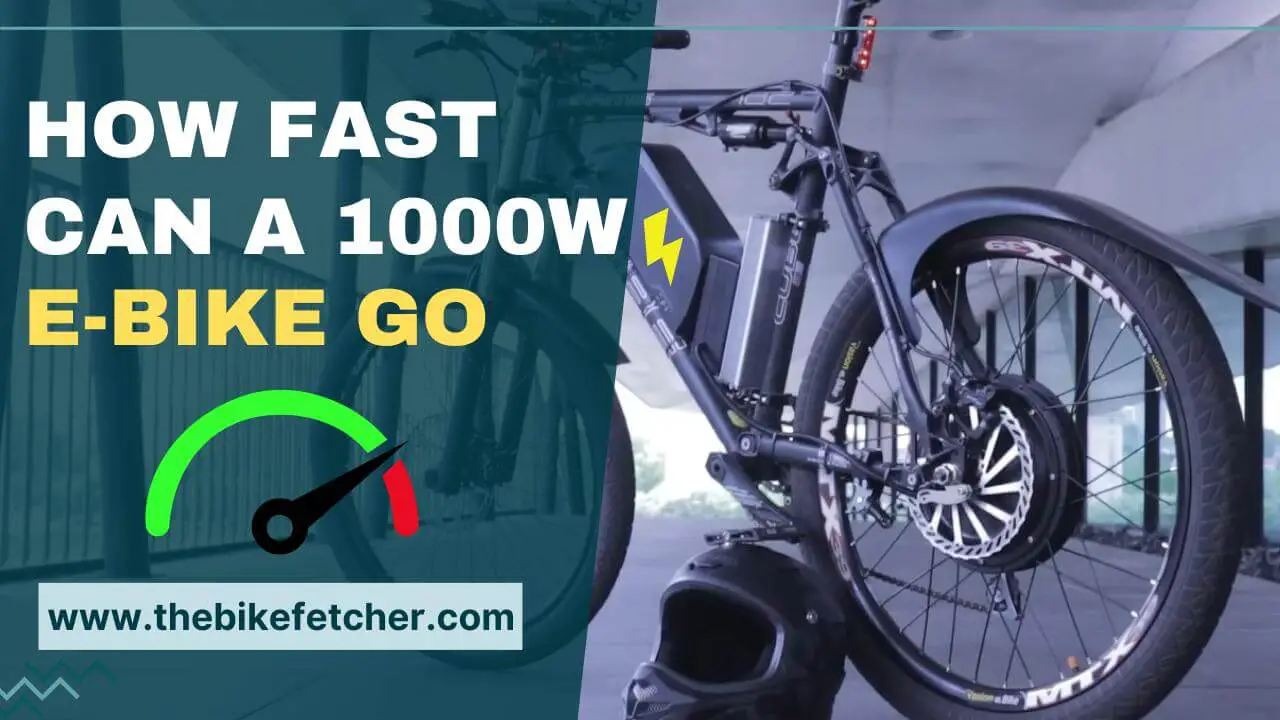Higher-wattage electric bikes are gaining well-deserving hype among riders of all ages and expertise because they accelerate faster making them perfect for trails.
I have already shared the top speed of a 750w electric bike but most of you want to know how fast can a 1000w electric bike go on various surfaces. So I tested this ebike on various surfaces.
Before you ride a 1000w ebike you must know if is it legal to ride in the USA, and what factors affect the speed. Don’t worry, We will discuss all these in this article.
I have also explained the basic terms you mostly see in ebikes so that you don’t get confused while reading this article. Let’s get started.
So, before we start the article on how fast can an ebike go, let’s know some of the basic terms you mostly see in ebikes so that you don’t get confused while reading this article. Let’s get started.
Terminologies in Electric Bikes
- Watts: Well, watts is the most used word when understanding any electrical gadget, equipment, or in this case: electric vehicle. It is a rating that tells how much energy the motor will consume constantly under operation. For different power needs the ebike comes in various watts.
- Amp: The SI unit of electric current is measured in Amps so the amp of your e-bike tells you what your bike’s maximum current output will be. The higher the amps, the more powerful your bike will be. Whereas, the Amp Hours are like your car’s fuel tank. The higher the ampere-hours, the more life your battery will have left after you ride uphill.
- Volts: Volts are indicative of the amount of pressure that can be contained within the battery. Batteries manufactured for electric mountain bikes start from 24 volts and go to 72 volts. A higher voltage battery provides more power to the ebike motor.
Mathematically, Watt = Volts x Amp
For the efficient functioning of a 1000-watt e-bike, Volts should be approximately 48 and Amp should be approximately 20.
Understanding Your Electric Bike and Its Components
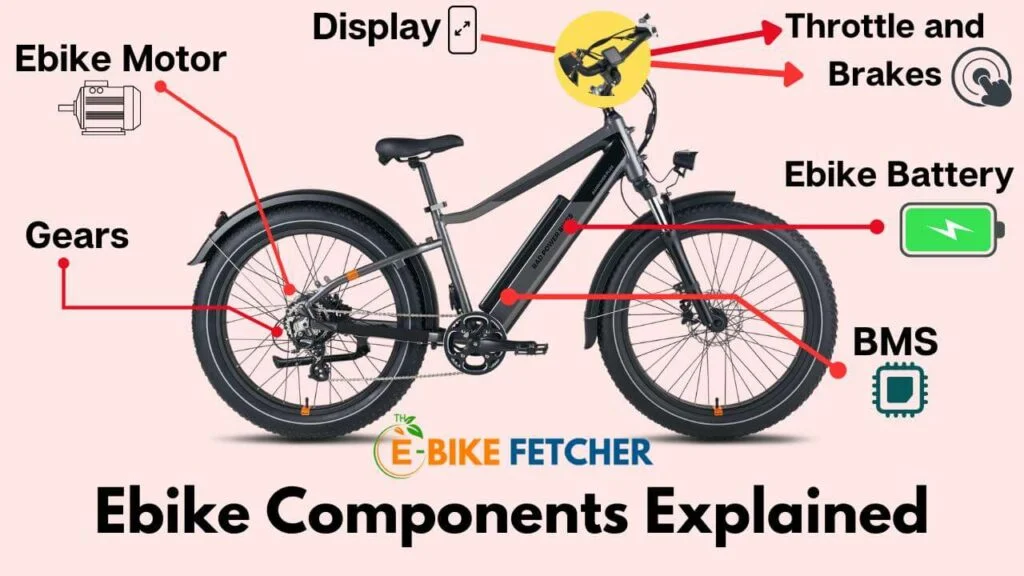
For a layman’s understanding, there are only 3 parts in an e-bike viz a battery, motor, and frame. But, for an engineer’s approach an ebike consists of many parts that affect the speed and efficiency, these are mentioned below:
1. Ebike Motor
The motor converts the charge received from the battery into power that sets the bike into movement. There are various types of motors such as brushed, brushless, stepper, etc.
There shall be more torque in your motor to carry you and your bike. Once you are convinced that the motor can take up your and your bike’s weight and cover a particular distance on a single charge, you can proceed with that motor.
2. Ebike Battery
Usually, riders use double batteries to increase speed, for backup in case of discharge, or to cover long distances. However, it is important to comprehend that the weight of the bike will decrease overall velocity.
Certified branded lithium-ion batteries are recommended in case you want to speed up your 1000-watt e-bike as it is smaller and lighter in size.
3. Gears
Gearless bikes will be easier to operate but will offer you less speed. You need to work on the torque and gear ratio to find out the motor and then you are good to go.
4. Battery Management System (BMS)
A battery management system is a chip-like setting inside your battery that manages the inflow and outflow of current and protects your e-bike from any damage from the voltage.
5. Throttle and Brakes
The throttle is just like a rheostat. When you twist or push the throttle e-bike accelerates and increases its speed. You don’t need to pedal when you are using throttle mode.
However, the brake system consists of gear and throttle management. When a brake is applied, it decreases the throttle and changes gear. Most ebikes have disc brakes for an instant braking experience.
6. Wheels
Large and wider wheels require more torque. Therefore it’s suggested to go for smaller wheels if you are using the e-bike for commuting within the city or medium-sized wheels for rough terrains.
7. Display
It’s very important to have a display on a higher-wattage ebikes (1000 watts) as it shows a lot of important information such as battery charge level, distance traveled, speed, and so on.
How Does a 1000w Electric Bike Work at High Speed?
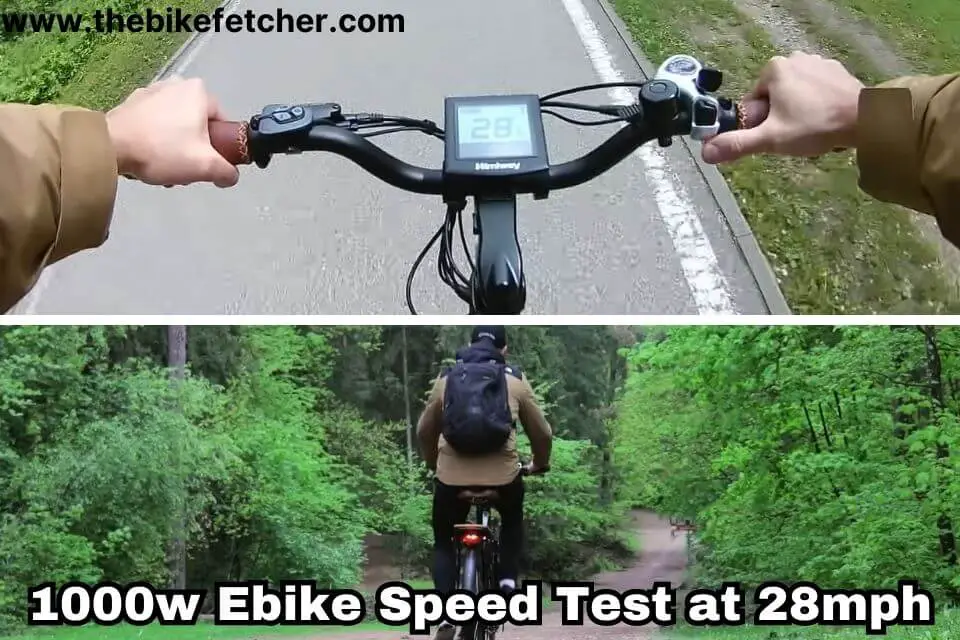
Unlike the traditional bicycle, a 1000-watt ebike runs effortlessly to retain a high speed of up to 40 mph on plane roads as it is made for riding at high speeds.
But, what are the factors that count to speed maintenance? Let’s have a look:
Weight distribution
Electric bikes are heavier than traditional bicycles due to the added weight of the battery, motor, gears, and throttle. This weight reduces the speed of a 1000-watt e-bike and makes turning or cornering a little struggle.
However, this weight is negligible when the motor starts assisting at high speeds. Also, the added weight helps the rider maintain balance on the roads or trails while riding at high speeds (40 miles per hour).
If you are into off-roading events, hunting, or long-distance riding at high speeds, consider getting an electric bike with more than 1000 watts because a 3000w ebike offers around 50-55 mph effortlessly.
Frame design
The shape, size, and design of your e-bike’s frame may affect its handling at high speeds. Bikes that are specifically designed for mountaineering or run at high speeds have an altogether different geometry.
So a 1000-watt electric bike must have a strong and a bit heavy frame to conquer the trails easily and safely. The frame should be a bit aerodynamic and must be perfect for your height.
Tires
At high speeds, the breadth, condition, and type of the tires affect the handling of an e-bike. Wider tires provide better stability and grip at high speed, while thin tires can reduce traction and affect handling which can sometimes lead to accidents.
Bike suspension
Suspension can be either front or full, and can vastly affect the handling of an e-bike at lofty speeds. Suspension acts as a sponge and helps to absorb bumps and vibrations, providing an effortless ride and adequate control.
You know riding an ebike at high speed is easy but managing that speed in different scenarios is very difficult therefore, always remember the above points while riding a 1000w ebike at high speeds.
How Fast Can a 1000w Electric Bike Go?
The speed you can accomplish on an e-bike with just the throttle depends on various factors such as:
- The wattage of the motor: A higher motor wattage gives more speed and vice-versa.
- Terrain (flat or inclined): A 1000w ebike runs faster on plane roads as compared to inclined roads (flyovers).
- Battery capacity: High voltage battery (compatible with the motor) supplies enough current to the motor for running at high speeds.
- Controller’s capacity: If the controller’s amp is restricted to a certain level, the ebike motor will provide high speed.
- Weight of the rider: If your weight is heavy, ebike speed will reduce.
Generally, the majority of e-bikes (250w to 750w) with throttle only deliver a maximum speed of 20 mph to adhere to regulations in the United States. When it comes to pedal assistance mode, the motor assists up to 28 mph only.
You can ride beyond this limit but you need to pedal with your power, which is not easy on a heavy bike like a 1000w ebike.
Although there are a variety of high-end 1000-watt electric bikes, the majority of them can reach speeds of 35-40 miles per hour on plane roads. These bikes are classified as mopeds or electric motorbikes.
When I ride the 1000w ebike on hills, I could achieve a maximum speed of up to 20 mph. However, my average speed was around 15 mph because of uneven surfaces.
You need a license for riding a 1000w ebikes and follow all the traffic rules that other vehicles (cars, motorbikes, scooters, etc) follow. However, this rule doesn’t apply to some states in the USA.
It’s noteworthy that riding an e-bike at high speed involves additional risks, such as reduced control and extended stopping distances. One must follow the traffic rules and regulations, and wear proper safety gear while driving at high speed.
Related: How fast can a 2000-watt electric bike go?
How fast can a 1000w ebike go on flat roads?
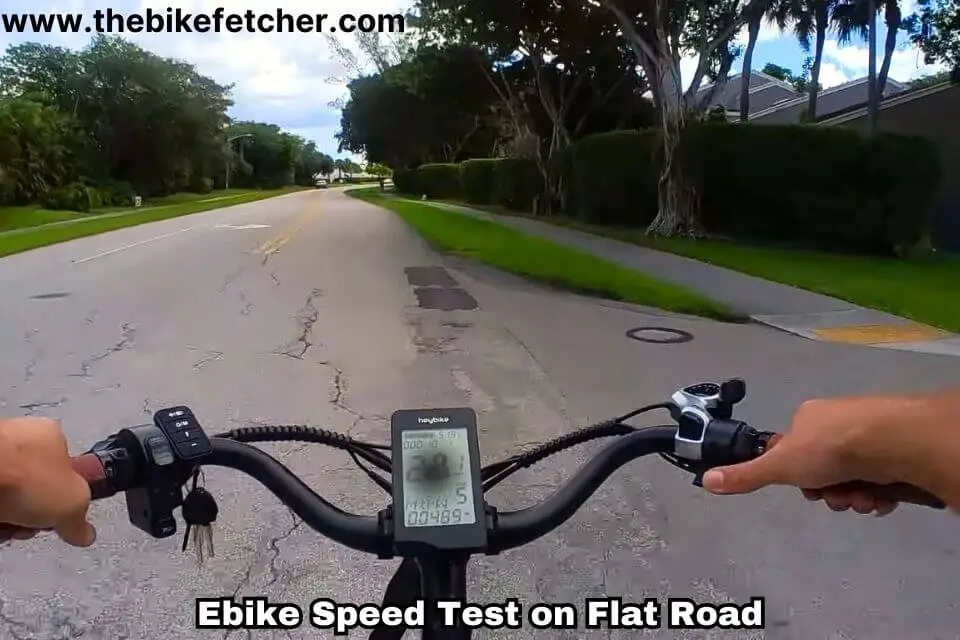
In the USA, all legal e-bikes must have a rating of class 1, class 2, or class 3. Class 1 and 2 have a speed limit of 20 mph (class 1 has no throttle assistance, class 2 has throttle assistance), and 28 mph for class 3 (without throttle).
As your e-bike reaches the threshold limit the motor stops assisting you. To move faster than the prescribed limit you will need to put 100% of the effort into pedaling.
An e-bike outside the aforesaid classes must only be used off-road to adhere to the law of the land and maintain public security and personal safety.
There are a few e-bikes that may go slower than their warranted speed because the motor isn’t powerful enough for the rider or due to speed limitations from the manufacturing company which is usually the case with hub drive motors and not with mid-drive motors. Learn more.
How Fast Does a 48v 1000w Electric Bike Go?
The speed of a 48v 1000w electric bike depends mainly on battery voltage, if the battery voltage is not equal to the motor’s voltage, you won’t get the top speed. So in this case, you need to pair your 1000w motor with a 48v battery.
Once your 48v 1000w ebike motor starts getting power from a 48v 20Ah battery, you will get a maximum speed of up to 40 miles per hour and this speed will also depend upon your weight, the place you ride on, and so on. I have already explained these factors above.
A fully charged 48v ebike battery has a voltage of around 52 volts and it starts reducing when the battery level reduces. Therefore, keep your ebike battery charged, it does not take much time to charge your 48V battery.
In case, If you have a 36v ebike: How Fast Can a 36V Electric Bike Go?
How Far Can You Ride on a 1000-Watt Ebike?
As mentioned earlier, the miles your e-bike can cover depends on the battery capacity and other factors like terrain, the inclination of the surface, your weight, the pressure you exert on the pedals, etc.
If you’re planning to travel on relatively flat or occasionally hilly terrains you can expect to get up to an unbelievable 60 miles round trip when your ebike is paired with a 48v 20Ah battery.
As you gain experience in riding ebikes, you’ll become familiar with how to conserve battery while riding to maximize your distance on a single charge.
Pros and Cons of a 1000-Watt Electric Bike
| Pros | Cons |
|---|---|
| Heavy battery increases bike weight. | High-maintenance ebike. |
| Great acceleration. | High maintenance ebike. |
| Moves like butter on hilly terrain. | Very expensive. |
| High wattage means greater power. | High-maintenance ebike. |
| High-end battery. | Useless for short commutation. |
| Can reach a top speed of 40mph. | Doesn’t fit the criteria of legal rules of the U.S.A. on country roads. |
How Steep Inclination Can a 1000w Ebike Climb?
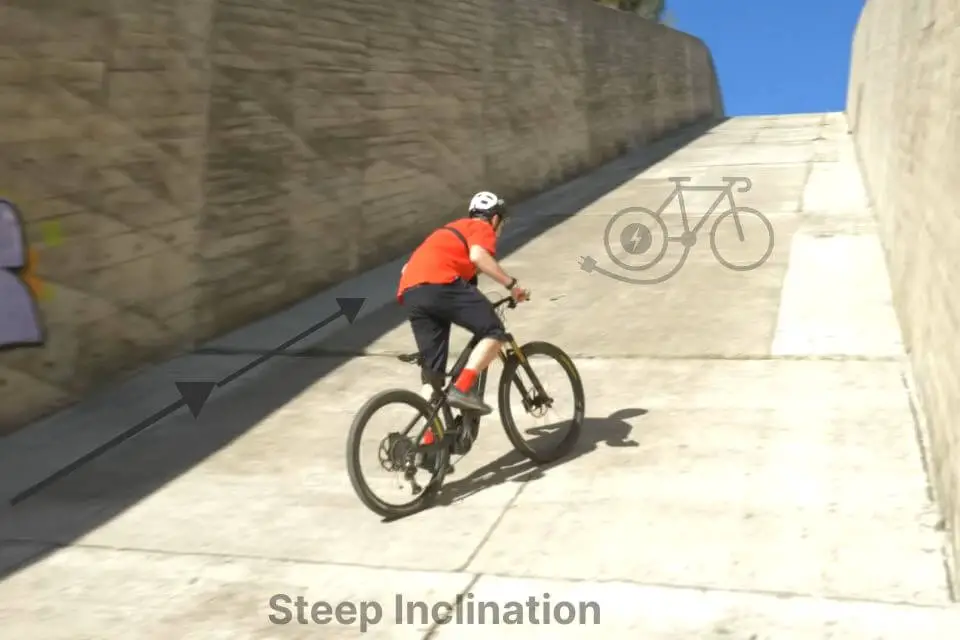
Whether an ebike covers the angle of the hilly triangle or not depends on a wide variety of factors, including the motor power, the rider’s weight, the type of wheels, the kind of terrain, etc.
Commonly speaking, electric bikes with more potent motors and gigantic wheels can handle sharp hills and greater inclinations than those with undersized motors and wheels.
A 1000-watt electric bike is capable of climbing hills with gradients up to 25 percent. It shouldn’t be neglected that climbing steep slopes will drain the battery faster, the riders should be well-equipped with recharging points.
Irrespective of the efficiency of a 1000-watt ebike, pedal assistance is a must. The rider should use his power to some extent, especially when climbing steep inclines. The electric motor provides an extra boost to make the climb easier and less laborious.
1000w Electric Bike Top Speed Test by Watching this Video
Final Thoughts About 1000w Electric Bike Top Speed
A 1000-watt e-bike is a powerful beast that picks up acceleration like a pro and helps maintain amazing speed with gentle pedaling. It’s best for longer rides and when you need to cover hilly terrains.
A 1000-watt e-bike runs against the gushing wind and irrespective of your weight, it has enough strength to carry you to faraway destinations with ease!
Related articles:
- Why should you charge your ebike battery to 80% only?
- Why does an ebike battery become dead? How to revive & charge it?
- Common causes for your ebike battery catching fire!
I hope you got your answer on how fast can a 1000w electric bike go. Do share your thoughts by commenting below.
Keep Riding & Stay Safe!
Frequently Asked Questions (FAQs)
Q1. What size battery is perfect for a 1000w ebike to get maximum speed?
Battery voltage and Ah affect the bike speed. You should pair your 1000w ebike with a lithium-ion battery of 48v 20Ah. It is perfect for a 1000w ebike as it has approx. 1000 WH which can easily provide the required current to the motor. Learn how to calculate battery size for a 1000w ebike.
Q2. Is It legal to ride a 1000w electric bike in the USA?
Ebikes from 250w to 750w are legal in all the states of the USA. However, when it comes to more than 1000 watts ebikes, they are street-legal in some states (Georgia, Kansas, Minnesota, Oklahoma, Oregon, and Virginia). Learn more.
Q3. How fast is a 48v 1000w electric bike in mph?
Mostly 1000 watts motor has 48 volts because it offers excellent performance and speed on all types of terrains. The maximum speed it can offer is 40 mph on paved roads but that’s not allowed on roads using throttle mode.
Related Posts:

